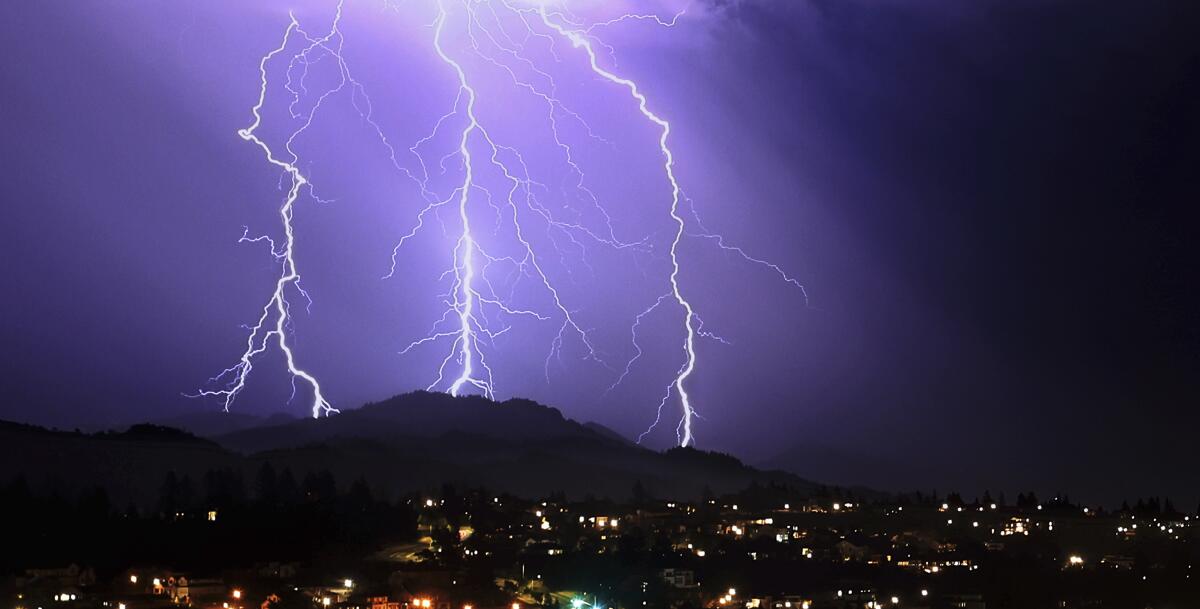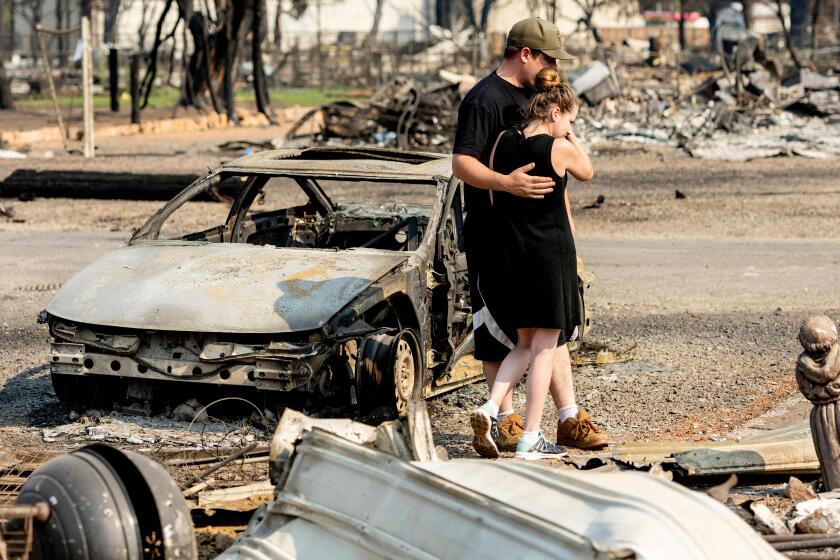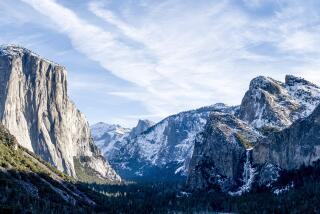Lightning starts new fires in California, while Dixie fire nears 1 million acres

- Share via
As lightning ignited several new fires across California, the Dixie fire raging north of Sacramento continued its relentless advancement this week, growing by nearly 22,000 acres overnight and moving ever closer to scorching 1 million acres, officials said.
Thunderstorms roiled large swaths of the state Thursday night, with accompanying lightning strikes starting several new fires in Northern California, while firefighters battled the Dixie fire — now a monstrous 950,591 acres — and a dozen other large blazes.
A fire that ignited Thursday night in the Kanaka Valley area of Rescue, in El Dorado County, was just over 6 acres and 5% contained by Friday morning — and constituted the largest of several new blazes in the area, according to Maurice Johnson, fire chief for El Dorado Hills and Rescue fire departments. More than 100 miles to the west, also late Thursday, crews in Mendocino County were battling what was dubbed the Rock Fire, burning south of Hopland.
Johnson estimated that hundreds of lightning strikes bore down on El Dorado, Sacramento and Amador counties amid intense storm cells that lasted several hours. Initially, he said, the lighting was “dry” — but it was followed by downpour early Friday morning.
“Hopefully that’ll help keep some of these fires down,” he said, noting that another blaze ignited about a quarter-mile from the one in the Kanaka Valley on Friday morning, but it was already contained.
Storms also brought much-needed rain to the burn areas of long-active fires, including over eastern portions of the Dixie fire, in Plumas County, and parts of the more than 200,000 acre-Caldor fire to the south, in El Dorado County, according to the National Weather Service. Rainfall was variable, but some areas saw up to a half-inch, said Scott McGuire, a meteorologist with the weather service’s Reno station, which covers about 36,000 square miles.
However, precipitation was scant in some northwestern portions of the Dixie fire — now extending like a demonic finger beyond the Lassen Volcanic National Park and into the Hat Creek area of Shasta County — where the fire saw explosive growth overnight. Higher elevations saw little to no rainfall, officials said.
The blaze, 59% contained after burning for nearly two months, is the second-largest fire in California history and is less that 100,000 acres from rising to the first — a grim designation currently held by the 2020 August Complex fire.
As the fire pushed north toward the Hat Creek Rim on Wednesday, the remote community of Old Station and surrounding areas were evacuated. Mandatory evacuation orders were expanded Thursday as the fire continued its tear, and additional warnings went out.
There have been no reports of damaged homes or commercial buildings in those areas, said Capt. Mitch Matlow, a spokesperson for the west zone of the Dixie fire.
“We have boots on the ground in there, and we are protecting those structures,” he said.
“We’re right smack in the middle of wildfire peak season,” Cal Fire Chief Thom Porter said. The outlook for the rest of the year includes more heat and dryness.
A red flag warning advising of critical fire weather — covering areas including western Lassen and eastern Plumas counties —remains in effect until 11 p.m. Friday, and fire officials were on high alert for plummeting humidity and fierce winds expected to arrive in the early afternoon.
Arriving from the southwest, winds are forecast to blow from 15 to 25 mph, with gusts up to 35 mph. At higher elevations — including parts of the Lake Tahoe region — winds could gust up to 50 to 60 mph, said McGuire, of the weather station. Humidity was expected to drop to 15% to 20%, while showers pushed off to the northeast.
“We’re going to transition right back into very dry air with gusty winds, right on the backside of abundant lightning overnight,” McGuire said.
Matlow said winds expected to arrive in the west zone of the Dixie fire carry a “potential for significant fire activity — very erratic behavior.” He said he expected winds in the area would top out at 20 mph in the valleys and up to 40 mph along ridge tops.
While areas of the Caldor fire enjoyed some rain, tamping down fire in several hot spots, officials said it would not make much of an impact on critically dry fuels and warned crews to stay vigilant. Since igniting Aug. 14, the blaze — now 218,459 acres and 53% contained — tore through the small town of Grizzly Flats before surging northeast to the doorstep of South Lake Tahoe.
“We have new lightning starts all around us,” said Anale Burlew, a unified incident commander for the Caldor fire told firefighters during a briefing Friday morning. She urged crews not to let “these few raindrops lull us into a sense of complacency,” noting that resources have been pulled to address new blazes elsewhere.
Firefighters were diverted from the Caldor Fire to fight the lightning-sparked fires that took hold in El Dorado County, the California Department of Forestry and Fire Protection’s Amador-El Dorado unit said in an online post.
More than 14,600 firefighters are attacking 13 large wildfires rampaging across the state, and officials said the large, concurrent blazes are straining limited resources, including personnel and equipment.
Wildfires haves torched more than 2 million acres across California this year.
Climate experts and fire officials express concern that the state’s destructive wildfire season may only worsen this fall with the arrival of intense seasonal winds.
More to Read
Sign up for Essential California
The most important California stories and recommendations in your inbox every morning.
You may occasionally receive promotional content from the Los Angeles Times.












